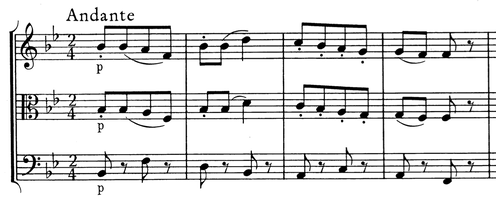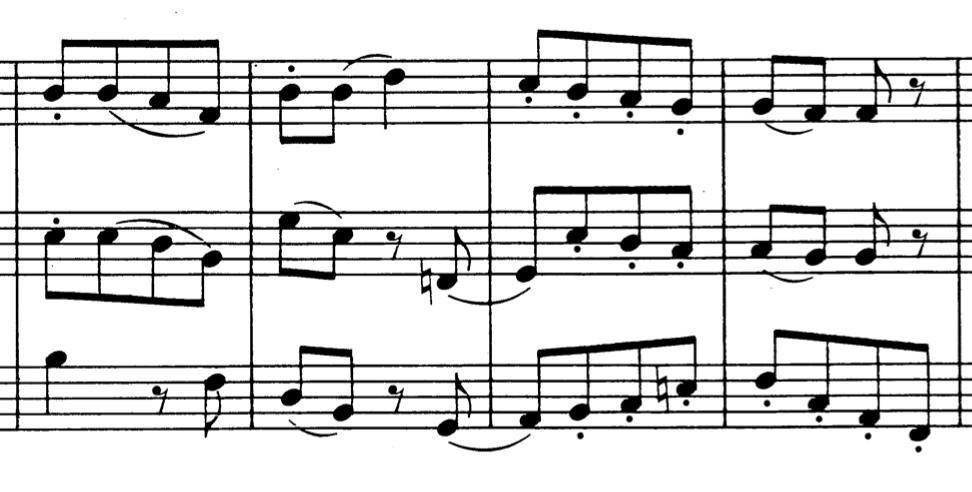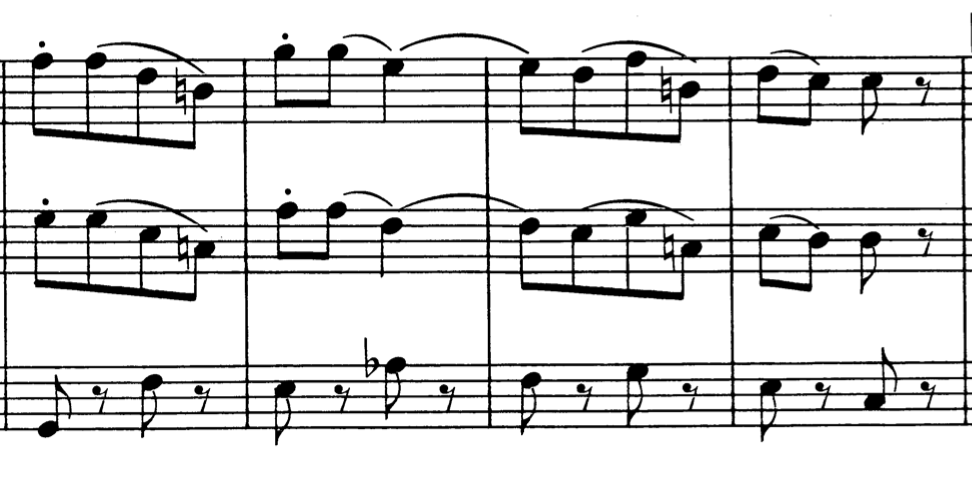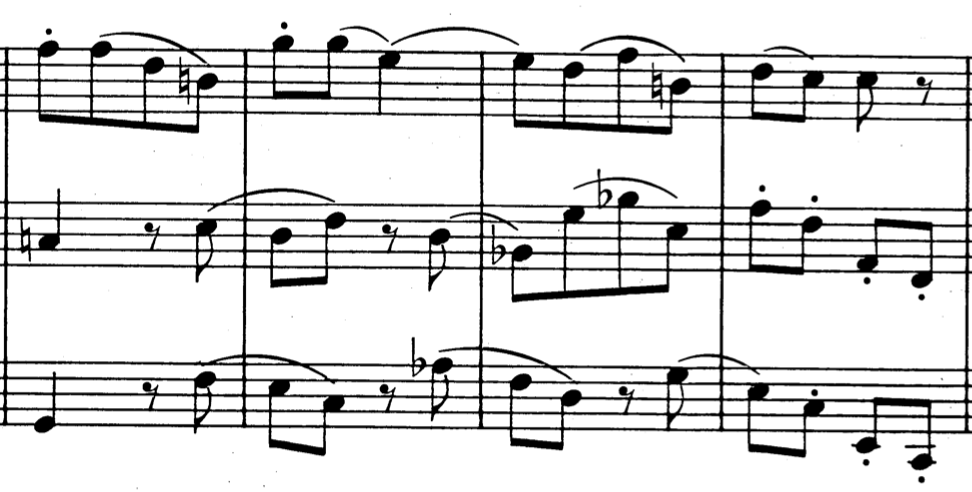Audio & Insight |
Mozart Divertimento for String Trio, K563, mvt. 4 — Andante |
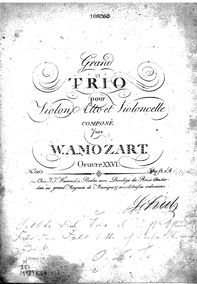
The fourth movement of the Divertimento K. 563 contains a very unusual set of variations. Typically, a 'theme and variations' proceeds in a very linear way, with each variation developing upon its predecessors using a single character or method. But in this set, each variation is in fact two variations – two types of development, intertwined. Its architecture is more than a little bit like a sonnet, and especially like the one from Act 1, scene 5 of Romeo and Juliet, where Shakespeare sneaks a sonnet ABAB CACA DEDE FF into R+J's dialogue.
Mozart writes the first variation ABAB; the second CDCD, the third EFEF, the fourth GgGg, in minor. For the fifth variation, the work breaks free in a running violin line, without repeat, HH. The discussion (and audio) below will explore how this works.
Mozart writes the first variation ABAB; the second CDCD, the third EFEF, the fourth GgGg, in minor. For the fifth variation, the work breaks free in a running violin line, without repeat, HH. The discussion (and audio) below will explore how this works.
|
ROMEO [To JULIET]
If I profane with my unworthiest hand This holy shrine, the gentle fine is this: My lips, two blushing pilgrims, ready stand To smooth that rough touch with a tender kiss. JULIET Good pilgrim, you do wrong your hand too much, Which mannerly devotion shows in this; For saints have hands that pilgrims’ hands do touch, And palm to palm is holy palmers’ kiss. ROMEO Have not saints lips, and holy palmers too? JULIET Ay, pilgrim, lips that they must use in prayer. ROMEO O, then, dear saint, let lips do what hands do; They pray, grant thou, lest faith turn to despair. JULIET Saints do not move, though grant for prayers’ sake. ROMEO Then move not, while my prayer’s effect I take. (Act I, scene 5 ) |
There is a strange mix of lightness and ingenuity throughout the entire Divertimento which shows up in this intricate variation scheme. Long though the six-movement Divertimento is, it never strays too far from a light and gentle category of music, much as the Magic Flute (with which it shares the key of E-flat) mixes heavy Masonic and moralistic themes with complete and utter silliness.
There are no dark harmonic ventures in this movement, and there is no need for a dense analysis of that kind. But these formal tricks are worth a close look. Knowing that they are there can to some extent explain, and probably enlarge, the sheer charm of this movement's progress. |
Theme (A + B)
The beginning is a bit of a trick. It seems to be a childishly simple melody, eight bars long, played twice. But it doesn't actually repeat. Here are the first eight bars:
And here is the apparent repeat of the first eight bars -- clearly the same theme, but also evidently higher-dimensional:
The second half also makes its repeat with lightly noticeable changes. Here is the first version of the second half:
...and here the second, again made significantly richer with a few changes:
One final thing to notice: the second half has an odd shape. There is an extra phrase at the end, after it should have ended. This creates a funny sense of imbalance (an extra 4 bars) even as it creates a large scale balance in the phrase.
Even as this theme itself gives the impression of being absolutely trivial, the motions and mechanisms around and beneath it give the sense that something is up. Here's the whole thing:
Variation 1 (C + D)
At first, the first variation (or is it already the second?) seems to make only the slightest departure from the theme: It's clearly audible in the viola. But the second time around, there is no clear evidence of the theme at all.
Variation 2 (E + F)
In the third variation, it seems right to say that an opera breaks out -- but it's probably more accurate to say that two operas break out. Or at least two scenes: one an aria, and one a melodrama.
Variation 3 (G + g) - Minor
Then, suddenly, it simplifies -- in all but mood. The minor variation almost repeats itself (the violin and cello trade the theme). But something else happens, too: the second half of the theme itself is shortened and balanced, answering the first eight bars with eight bars instead of sixteen. Amidst the brightness of the other variations, it is a startlingly deep and ceremonial-sounding departure.
Variation 4
Finally there is a single variation, this time with no repeat at all. The violin takes flight, the viola sings a tonal outline, and the bass walks.
The surprise this time is that there are extra extra bars before resolution at the end of the theme: the viola repeats the cadence, and then to make sure that we really come to the end, the cello repeats it. So there are even more extra bars....
The surprise this time is that there are extra extra bars before resolution at the end of the theme: the viola repeats the cadence, and then to make sure that we really come to the end, the cello repeats it. So there are even more extra bars....
Coda
...and the coda couldn't be simpler.
© Timothy Summers
